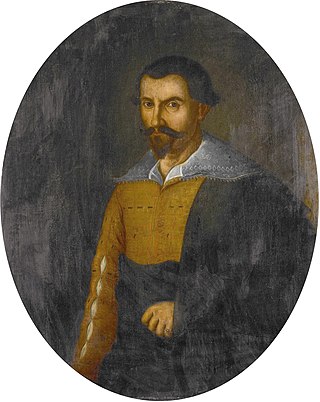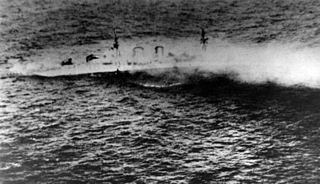
HMAS Burnie (J198/B238/A112), named for the city of Burnie, Tasmania, was one of 60 Bathurst class corvettes constructed during World War II and one of 20 built for the Admiralty but manned by personnel of and commissioned into the Royal Australian Navy (RAN).

The Battle of the Java Sea was a decisive naval battle of the Pacific campaign of World War II.

The Battle of Sunda Strait was a naval battle which occurred during World War II in the Sunda Strait between the islands of Java, and Sumatra. On the night of 28 February – 1 March 1942, the Australian light cruiser HMAS Perth, American heavy cruiser USS Houston, and Dutch destroyer HNLMS Evertsen faced a major Imperial Japanese Navy (IJN) task force. After a fierce battle lasting several hours, all Allied ships were sunk. Five Japanese ships were sunk, three of them by friendly fire.
The Eendracht was an early 17th century Dutch wooden-hulled 700 tonne East Indiaman, launched in 1615 in the service of the Dutch East India Company (VOC). Its Dutch name means "concord", "unity" or "union", and was a common name given to Dutch ships of the period, from the motto of the Republic: Concordia res parvae crescunt . The ship was captained by Dirk Hartog when he made the second recorded landfall by a European on Australian soil, in 1616.

The Zaandam, or Sardam, Saerdam and Saardam, was a 17th-century yacht of the Dutch East India Company. It was a small merchant vessel designed primarily for the inter-island trade in the East Indies.
Ridderschap van Holland was a large retourschip, the largest class of merchantmen built by the Dutch East India Company to trade with the East Indies. In 1694 the ship sailed for Batavia on her fifth voyage, but was never heard from again. She is now thought to have been shipwrecked off the west coast of Australia.

Jan Huygen van Linschoten was a Dutch spy, merchant, traveller and writer.

Pieter de Carpentier was a Dutch administrator of the Dutch East India Company (VOC) who served as Governor-General there from 1623 to 1627. The Gulf of Carpentaria in northern Australia is named after him.

Hubert Hugo served as a merchant for the Dutch East India Company (VOC) from 1640 to 1654 in Gujarat. He later turned to privateering or piracy in the Arabian Sea and the Gulf of Aden around 1662. In 1664, he was acquitted by the States of Holland and returned to the service of the VOC. He served as commander of Mauritius until 1677. In 1674 he became one of the last people to document the presence of the dodo on Mauritius.
't Wapen van Hoorn was a 17th-century Dutch East India Company fluyt with a tonnage between 400 and 600, built in the Dutch Republic in 1619. During its second voyage it grounded on the west coast of Australia, making it about the tenth ship to make landfall on Australian soil, and following Tryall just a few weeks earlier only the second ship to be shipwrecked in Australian waters, albeit temporarily.

The Second Battle of the Java Sea was the last naval action of the Netherlands East Indies campaign, of 1941–42. It occurred on 1 March 1942, two days after the first Battle of the Java Sea. It saw the end of the last Allied warships operating in the waters around Java, allowing Japanese forces to complete their conquest of the Dutch East Indies unhindered.
Aagtekerke was a ship of the Dutch East India Company built in 1724. It was lost without trace during its maiden voyage in 1725–26, sailing from Cape of Good Hope in the Dutch Cape Colony to Batavia in the Dutch East Indies.

Leeuwin, was a Dutch galleon that discovered and mapped some of the southwest corner of Australia in March 1622. It was captained by Jan Fransz and was the seventh European ship to sight the continent.
Thirteen ships of the Dutch East India Company and its pre-companies have been named Amsterdam.
The Concordia was a Dutch sailing ship of the Dutch East India Company that left Batavia on 15 January 1708 with two other vessels, Zuiderburg and Mercurius. Concordia had 130 people on board and was bound for the Cape of Good Hope and then the Netherlands. She was last sighted by Mercurius in open seas to the south of the Sunda Strait on 5 February 1708, in bad weather.
William Bryant was a Cornish fisherman and convict who was transported to Australia on the First Fleet. He is remembered for his daring escape from the penal colony with his wife, two small children and seven convicts in the governor's cutter, sailing to Timor in a voyage that would come to rank alongside that of fellow Cornishman William Bligh as one of the most incredible ever made in an open boat.
Stedcombe was a ship launched at Lyme Regis in 1818. She traded between London and the Cape of Good Hope, and the Cape and the Dutch East Indies. Local pirates at Timor Laut murdered her crew in 1825.
The Leeuwin was a 400-ton jacht of the Dutch East India Company that travelled to the East Indies twice starting 3 April 1653. It wrecked near Macassar on 24 December 1664.
Honkoop, also written as Honcoop or Hencoop, was an 18th-century East Indiaman of the Dutch East India Company. She was a merchant ship that made multiple voyages from Texel, Dutch Republic to Batavia, the Dutch East Indies. The Royal Navy captured her in 1781 during the Battle of Saldanha Bay. In 1782 during a gale, the ship with up to 313 crew members, was lost; she was believed to have foundered with all hands.








